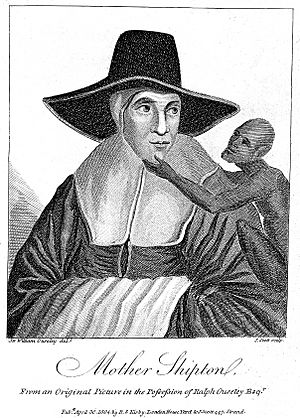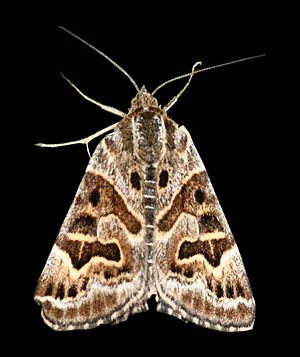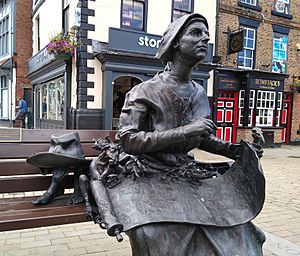Mother Shipton facts for kids
Quick facts for kids
Mother Shipton
|
|
|---|---|

An 1804 portrait of Shipton with a monkey or familiar, taken from an oil painting dating from at least a century earlier
|
|
| Born |
Ursula Southeil
c. 1488 Knaresborough, North Yorkshire, England
|
| Died | 1561 (aged 72–73) |
| Other names | Ursula Soothtell, Ursula Sontheil |
| Occupation | Fortune-teller, prophetess |
Ursula Southeil (born around 1488, died 1561), also known as Mother Shipton, was a famous English soothsayer and prophetess. People in English folklore often remember her for her predictions and unusual life.
Some stories describe her as a witch. She is linked to the legend of the Rollright Stones in Oxfordshire. This legend says a king and his men turned to stone after failing a test she gave them.
The first book of her prophecies was printed in 1641, about 80 years after she supposedly died. This suggests that many of the stories about her were legends rather than true accounts. Early books about her mentioned mostly local predictions.
A well-known book about her prophecies, published in 1684, said she was born in Knaresborough, Yorkshire. Her birthplace was a cave, which is now called Mother Shipton's Cave. This book also claimed she was very ugly. It said she married Toby Shipton, a local carpenter, in 1512 and made predictions throughout her life.
Contents
Her Early Life
Mother Shipton was born Ursula Sontheil in 1488. Her mother, Agatha Soothtale, was only 15 years old. Ursula was supposedly born in a cave near Knaresborough in North Yorkshire. The earliest stories about her birth and life were written down by Richard Head in 1667 and J. Conyers in 1686.
Both sources say Ursula was born during a huge thunderstorm. They also claim she was born with a hunchback and bulging eyes, making her look different. Instead of crying, she supposedly cackled, and when she did, the storm stopped.
These old stories say Ursula's mother, Agatha, was a poor 15-year-old orphan. She had no way to support herself. The stories suggest that Ursula's birth was unusual, with some legends even claiming Agatha was a witch.
No one knows who Ursula's father was. Agatha refused to say, even when she was forced to appear before a local judge. Because of the mystery around her birth, Agatha and Ursula were often left out by society. They lived alone in the same cave where Ursula was born for her first two years.
Rumors spread that Agatha was a witch and Ursula was connected to evil. This was partly because the cave had a special pool shaped like a skull. This pool was known to turn things into stone. Today, we know the cave's water is full of minerals. Objects left in the water get coated with these minerals, making them hard and stone-like.
According to 17th-century stories, after two years in the Forest of Knaresborough, the abbot of Beverley helped them. He moved Agatha to a convent and found a foster family for Ursula in Knaresborough. Agatha and Ursula never saw each other again.
From old descriptions, it seems Ursula likely had a large, crooked nose, a hunchback, and crooked legs. Her unique looks reminded people of her mysterious birth. Even though she found acceptance with her foster family and a few friends, most townspeople avoided her. She found comfort in the woods, like her mother had. There, she spent her childhood learning about plants and herbs and their healing powers.
Childhood Legends
Stories say that when Ursula was two, her foster mother left her alone at home. When her mother returned, the front door was open. Frightened, she called neighbors for help. They heard a loud wailing sound, like "a thousand cats," coming from inside. Ursula's cradle was empty. After searching, her mother looked up and saw Ursula cackling, sitting on the iron bar above the fireplace where cooking pots hung.
Another story from 1686 tells of a time when important men from the town were meeting. Ursula walked past them on an errand. The men stopped to make fun of her, calling her "hag face." Ursula kept walking. But when the men sat down, strange things happened. The collar of one man's shirt turned into a toilet seat around his neck. The man next to him laughed, and his hat suddenly became a chamber pot. The townspeople laughed loudly. The master of the house came to see what was happening. When he tried to enter, he found himself blocked by large horns that had suddenly grown from his head. The story says these strange things soon went back to normal. The townspeople took it as a sign not to make fun of Ursula in public.
Adult Life
As Ursula grew up, her knowledge of plants and herbs also grew. She became a valuable herbalist for the townspeople. The respect she gained from her work helped her meet new people. That's how she met Toby Shipton, a local carpenter.
When Ursula was 24, she and Toby Shipton got married. From then on, Ursula used her husband's last name and became known as Mother Shipton. People in town were surprised by their marriage. They whispered that Toby must have been "bewitched" to marry her.
About a month after she married, a neighbor came to her door. The neighbor said a thief had stolen her new smock and petticoat. Mother Shipton calmly told her neighbor she knew who took the clothes and would get them back the next day. The next morning, Mother Shipton and her neighbor went to the market cross. The woman who stole the clothes couldn't stop herself from putting on the smock over her clothes, holding the petticoat, and marching through town. When she reached the market cross, she started dancing. She danced right up to Mother Shipton and her neighbor, singing, "I stole my Neighbours Smock and Coat, I am a Thief, and here I show't." When she reached Mother Shipton, she took off the smock, gave it back, curtsied, and left.
Two years later, in 1514, Toby Shipton died. Some townspeople wrongly believed Ursula was responsible. The sadness of losing her husband and the harsh words from the town led Ursula Shipton to move back into the woods. She went to the same cave where she was born, seeking peace. There, she continued to make healing potions and herbal remedies for people. Mother Shipton's name became more and more famous. People would travel long distances to see her and get her special remedies.
As her popularity grew, she became more confident and began to share that she could see the future. She started with small predictions about her town and its people. As these predictions came true, she began telling prophecies about the monarchy and the future of the world. In 1537, King Henry VIII wrote a letter where he mentioned a "witch of York." Some believe this was a reference to Mother Shipton.
Her Prophecies
River Ouse Predictions
Mother Shipton made a famous prediction about the River Ouse in York:
"Water shall come over Ouse Bridge, and a windmill shall be set upon a Tower, and a Elm Tree shall lie at every man's door".
The River Ouse was next to York, and Ouse Bridge crossed it. At first, this prophecy made no sense to the people of York. But later, the town got a system of pipes to bring water. This system brought water across Ouse Bridge. A windmill on a tower pumped the water into the pipes. These pipes were made from Elm trees and delivered water to every home in town.
She also predicted:
"Before Ouse Bridge and Trinity Church meet, what is built in the day shall fall in the night, till the highest stone in the church be the lowest stone of the bridge."
Not long after Mother Shipton said this, a huge storm hit York. During the storm, the steeple on Trinity Church fell. A part of Ouse Bridge was also destroyed and washed away by the river. Later, when repairs were made to the bridge, pieces of the fallen church steeple were used as the foundation for the new part of the bridge. This made Trinity Church and Ouse Bridge "meet." What was built in the day fell in the night, and the church steeple, once the highest stone, became the lowest stone of the bridge's foundation.
End of the World Prophecy
The most famous version of Mother Shipton's prophecies talks about many modern events. It is often quoted today as if it were real. It contains over a hundred rhyming lines. However, the language used is clearly not from the 16th century. This version includes the well-known lines:
The world to an end shall come
In eighteen hundred and eighty one.
This version was not published until 1862. More than ten years later, the real author, Charles Hindley, admitted that he had made up the manuscript.
This made-up prophecy was published over the years with different dates. For example, a booklet from the 1920s predicted the world would end in 1991. In the late 1970s, many news articles talked about Mother Shipton predicting the world would end in 1981.
Technology Predictions
Other famous lines from Charles Hindley's made-up version, often quoted as if they were real, include:
A Carriage without a horse shall go;
Disaster fill the world with woe...
In water iron then shall float,
As easy as a wooden boat.
These lines hint at inventions that did not exist in Mother Shipton's time but were real in Hindley's time. These include trains (carriages without horses) and iron ships (iron floating like wood). They also suggest events like wars and conflicts.
Was She Real?
Based on old writings and many stories about her life, historians believe Mother Shipton was a real woman. She was born in 1488 to a 15-year-old orphan named Agatha Soothtale. Her birthplace was a cave in North Yorkshire, near Knaresborough. Old records often mention her appearance. She likely had a hunchback and a large, crooked nose, though other details about her looks are guesses. She made potions, herbal remedies, and predicted the future.
In 1537, King Henry VIII wrote a letter to the Duke of Norfolk. In it, he mentioned a "witch of York." This was during a time when Catholic people were protesting against the closing of monasteries. Many believe this letter is the earliest real mention of Mother Shipton. She would have been making predictions about Henry VIII around this time. In 1666, Samuel Pepys wrote in his diary that he heard the Royal family discussing Mother Shipton's prophecy about the Great Fire of London.
The first book of Mother Shipton's prophecies was published in 1641, 80 years after her death. The story goes that a woman named Joanne Walker wrote down Mother Shipton's life story. She heard it as a young girl when Mother Shipton spoke about her life. Mother Shipton herself never wrote anything down or published any books.
The cave where she lived is known as England's oldest tourist attraction. For hundreds of years, people have visited the cave where she was born. The water in this cave has so many minerals that anything placed in the pool slowly gets covered in layers of stone. Tourists often put items in the pool and return later to see them "turned to stone." It is thought that many of her prophecies were never written down. Also, many legends and predictions linked to her were created after she died to make her folk legend even bigger.
Her Legacy
Mother Shipton became a very famous figure in folklore. Her name was connected to many sad events and strange happenings in the UK, North America, and Australia during the 17th, 18th, and 19th centuries. Many fortune-tellers used her image or statues to attract customers. Many English pubs were named after her. Only two still exist today: one near her supposed birthplace in Knaresborough and another in Portsmouth. The Portsmouth pub has a statue of her above its door.
A funny drawing of Mother Shipton was used in early pantomime shows. Her appearance in pantomime was mentioned in an 18th-century song from Yorkshire, which says: "Of all the pretty pantomimes/ That have been seen or sung in rhimes,/Since famous Johnny Rich's times,/There's none like Mother Shipton."
The Mother Shipton moth (Callistege mi) is named after her. The pattern on each of its wings looks like a witch's head from the side.
In 2013, a fundraising effort began to raise £35,000 for a statue of Mother Shipton in Knaresborough. The statue was finished in October 2017. It sits on a bench in the town's Market Square, near a statue of John Metcalf, an 18th-century road engineer known as Blind Jack.
Mother Shipton is also mentioned in Daniel Defoe's book A Journal of the Plague Year (1722). This book talks about the bubonic plague in London in 1665. Defoe wrote that people were so scared they went to fortune-tellers and astrologers. He noted that signs for these people were common, often showing "Friar Bacon's brazen-head" or "the sign of Mother Shipton."
See also
- 2012 phenomenon






